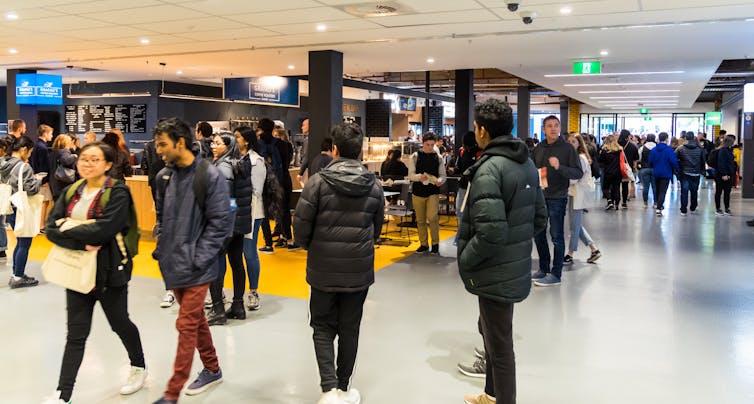Most of Australia's uni leaders are white, male and grey. This lack of diversity could be a handicap
- Written by Siew Fang Law, Senior Lecturer, Melbourne Graduate School Of Education, University of Melbourne
Australian universities are diverse places. They are a mix of students, staff and communities from different demographic backgrounds.
This is not true of the people who run universities. Higher education leaders tend to have backgrounds that are “WEIRD”: Western, educated, industrialised, rich and democratic.
In 2018, of the 699 governing council roles across Australia’s 41 universities, 94% of the incumbents had Caucasian and British backgrounds. The top tiers of senior executives were 94% Caucasian and British in background, as were 96% of vice-chancellors.
Read more: Australia needs to confront its history of white privilege to provide a level playing field for all
What are the risks of homogenous leadership?
When top leadership are strikingly WEIRD, the culture of their institutions is too. This reproduces curriculum, library systems, research and thought paradigms that are also WEIRD. This kind of sameness across universities has consequences.
A large body of research shows homogeneous governance presents risks. These risks include groupthink, oversights and unchecked blind spots.
A range of risks and long-term implications are associated with under-representation in many sectors, including parliament, the legal sector, arts, journalism and media, military, films, creative writing and culinary industries.
Read more: Universities and government need to rethink their relationship with each other before it's too late
Australian higher education has not been immune to tunnel vision. We see it in the discourse of “internationalisation” policy in Australia universities. There has been a lack of global vision in the construction of many university strategies.
The structural issues in Australia and Australian universities are entrenched, yet have been denied for decades, if not centuries. If we want Australian higher education to meet our aspirations and to prepare future generations, we need to confront this elephant in the room.
A deterioration of public trust in universities and expertise has forced many universities in the Western world to the brink of existential crises. WEIRD leaders are struggling to redefine what the purpose of the university should be.
Read more: We are losing sight of higher education’s true purpose
Diverse leadership has many benefits
Diversity delivers a wide range of social, economic and policy benefits. Higher education needs diversity to continue to thrive, to open mindsets, to gain new viewpoints, to broaden paradigms and to widen ranges of solutions.
Research shows diverse groups outperform homogeneous groups in productivity and innovation over the long term. Universities need to play a long game too.
The pandemic is forcing Australian universities to transform. But if this transformation is to be successful, the voices of young people, women, Indigenous people, diasporas and people of diverse abilities need to be heard across all levels. The sector needs to enable talents with all perspectives to co-create new insights and ideas to move forward.
 The students at Australian universities are much more diverse than their leadership.
Nils Versemann/Shutterstock
The students at Australian universities are much more diverse than their leadership.
Nils Versemann/Shutterstock
Practical steps to diversify leadership
Beyond setting goals and informed targets, we can achieve a more diverse leadership with a few practical measures.
We can establish mentoring strategies and policies. These help ensure a more diverse range of people are in the leadership pipeline and have exposure to executive meetings.
We can create open and safe forums that promote dialogue about leadership issues. Universities need to have honest conversations about the complexities, challenges and barriers to achieving greater diversity in leadership. This includes being able to examine contested ideas such as decolonisation, quotas and meritocracy within the university system.
Read more: After coronavirus, universities must collaborate with communities to support social transition
We can engage young people and diverse groups using non-English media platforms to communicate key ideas to a wider and more diverse audience. This could shift attitudes toward the Anglophone-dominated status quo and create space for greater inclusion, both physically and intellectually.
The key to success will be empowering the “other” to advise leaders, become leaders and participate in problem-solving and decision-making.
We need to democratise workplaces through participation, to shift workplace relations and power dynamics. A mobilised and diverse university community could come up with more holistic, innovative and transformative solutions.
Diversity is integral to sustainability
More than ever, Australia’s higher education sector needs an intersectional lens, where leaders see the world through multiple perspectives and through the experiences of students and staff from different backgrounds.
Diversity in senior leadership is essential to give meaning to the assertion “we are all in it together” and to sustainable development. Acknowledging the interconnected nature of our society, universities need to reflect the ecology of knowledge that is integral to driving sustainable socio-cultural, environmental, economic and technological development.
Diverse leadership should be the norm as we imagine the “new normal”.
Authors: Siew Fang Law, Senior Lecturer, Melbourne Graduate School Of Education, University of Melbourne





